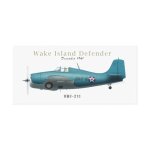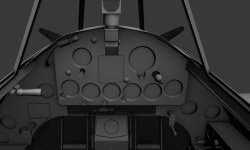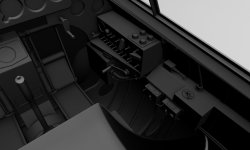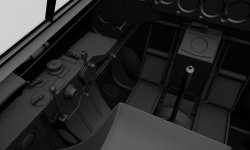Thank you to those who played the "guess that aircraft" game! Though it was rather short lived, it did allow me to announce the F4F Wildcat product that's currently in development at KC Flight Shop! This will be the official development thread were I will post progress, give information about the product, and hopefully get some community feedback!
First, let me tell you a little bit about the F4F project. This project started in 2003 as a true "museum" quality model, accurate to a very fine detail. Even down to modeling individual links in the landing gear chain and rivets on the aircraft's skin. The original model is over 10 MILLION polygons! To give you some perspective, many FSX models are around 50,000-150,000 for jumbo jets, or 250,000 for a super detailed model!!! The type of model that even rivet counters would be impressed by
Here is a render of the high detail model showing off the engine and landing gear bay.
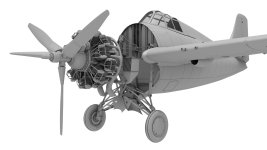
That model was never fully finished and the project it was for was canceled, but I kept plugging away at it every now and then in hopes to one day finish it. Some people may have seen bits and peace's of it on the forums, but its been on the backburner for some time. Until recently.
Recently, I gave myself the ask of turning this model into something that is useable in FSX, but still try and retain much of the detail and accuracy of the original! The model is completely re-done to a more acceptable FSX standard (under 200K polygons) but still retaining the detail using normal maps derived from the high detail model!
With that said, I would like to present to you early concept screenshots of the KCFS F4F Wildcat!
Please note that these are early screenshots within 3D Studio's Max, NOT RENDERS. Textures are a work in progress and this is still a ways away from flying in FSX/P3D.
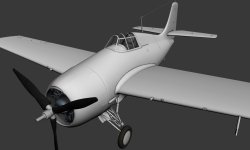

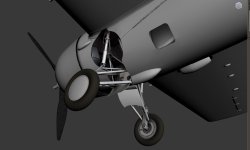
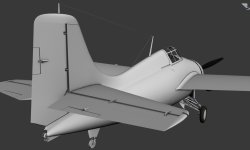
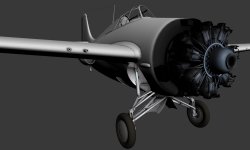
Please note that the engine texture is very dark, since its mostly shrouded in the cowl. I may have a "lit" version and allow the pilot to take off the cowl for screenshots to show off the detail. It all depends on what the community wants!
Currently there is NO ship date, and at best are months away from that. I currently have a full time job, and its not modeling aircraft. Im a very small developer, so progress will be slower then normal, but it WONT take me another 10 years =) Im in final and there are no go-arounds on this one!!!
I would love to get some feedback and comments from the community. Also if you spot something is wrong, feel free to let me know! I cant promise it will get fixed, but I will do my best to make this aircraft as accurate as possible. If you want to get a good idea of the quality KCFS is capable, feel free to take a look at the Republic Seabee! Fun little aircraft that's very versatile and unique! http://www.kcflightshop.com/?page_id=245 http://www.aerosoft.com/cgi-local/us/iboshop.cgi?showd,6647689100,D12766
Hopefully I will be able to post some screenshots of the cockpit Friday.
First, let me tell you a little bit about the F4F project. This project started in 2003 as a true "museum" quality model, accurate to a very fine detail. Even down to modeling individual links in the landing gear chain and rivets on the aircraft's skin. The original model is over 10 MILLION polygons! To give you some perspective, many FSX models are around 50,000-150,000 for jumbo jets, or 250,000 for a super detailed model!!! The type of model that even rivet counters would be impressed by
Here is a render of the high detail model showing off the engine and landing gear bay.

That model was never fully finished and the project it was for was canceled, but I kept plugging away at it every now and then in hopes to one day finish it. Some people may have seen bits and peace's of it on the forums, but its been on the backburner for some time. Until recently.
Recently, I gave myself the ask of turning this model into something that is useable in FSX, but still try and retain much of the detail and accuracy of the original! The model is completely re-done to a more acceptable FSX standard (under 200K polygons) but still retaining the detail using normal maps derived from the high detail model!
With that said, I would like to present to you early concept screenshots of the KCFS F4F Wildcat!
Please note that these are early screenshots within 3D Studio's Max, NOT RENDERS. Textures are a work in progress and this is still a ways away from flying in FSX/P3D.





Please note that the engine texture is very dark, since its mostly shrouded in the cowl. I may have a "lit" version and allow the pilot to take off the cowl for screenshots to show off the detail. It all depends on what the community wants!
Currently there is NO ship date, and at best are months away from that. I currently have a full time job, and its not modeling aircraft. Im a very small developer, so progress will be slower then normal, but it WONT take me another 10 years =) Im in final and there are no go-arounds on this one!!!
I would love to get some feedback and comments from the community. Also if you spot something is wrong, feel free to let me know! I cant promise it will get fixed, but I will do my best to make this aircraft as accurate as possible. If you want to get a good idea of the quality KCFS is capable, feel free to take a look at the Republic Seabee! Fun little aircraft that's very versatile and unique! http://www.kcflightshop.com/?page_id=245 http://www.aerosoft.com/cgi-local/us/iboshop.cgi?showd,6647689100,D12766
Hopefully I will be able to post some screenshots of the cockpit Friday.

 I'm a huge fan of the wildkitty!
I'm a huge fan of the wildkitty!

